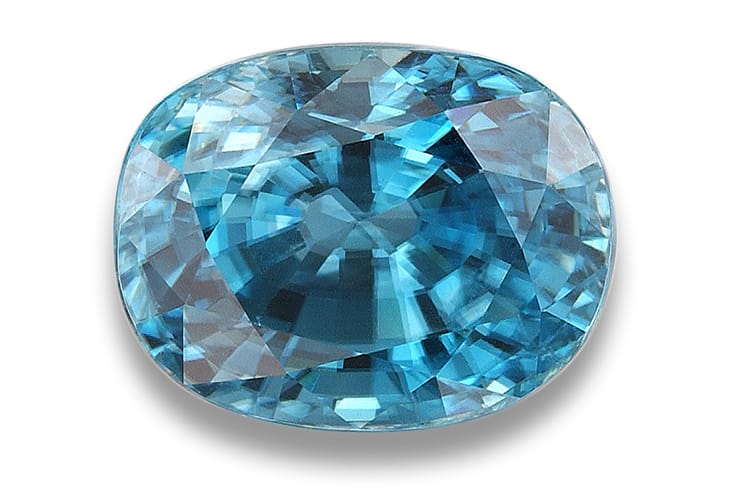Guide to Zircon

History, Lore and Appreciation
Zircon is winning over fans because of its unique colors and brilliant optical characteristics. The first thing to know about zircon is that it has nothing to do with cubic zirconia (a man-made product that has been used as a diamond simulant since the 1970s). Zircon is a natural gem that might be confused with diamond in its colorless varieties, but easily separated upon closer examination. The appeal of zircon’s many color varieties lies in its extraordinary lustre, brilliance and fire, a product of high refractive indices and very high dispersion.
Three types of zircon have been identified: high-type, or alpha; low-type, or gamma; and intermediate-type, or beta. The classification is related to the degree of alteration of the crystal structure. High- type zircon has an un-altered crystal structure, like most other crystalline gems. Low-type zircon is “metamict,” which means the crystal structure has been changed towards and amorphous state by natural irradiation. Partially crystalline gems, meanwhile, are in the intermediate- type classification. The appeal of metamict zircon lies in its unique, often phenomenal effects. The word zircon derives from the Arabic zargun, meaning gold colored, though, zircon is found in many colors. A range of red to orange, yellow to brown, and blue to green are found, though natural blue zircon is quite rare.
Another optical characteristic of zircon (except in metamict types) is its extreme double refraction, which is often easily visible when looking through a gem’s table with the naked eye. The result is a perceived doubling of the pavilion facets and facet junctions. Its very high dispersion is behind the gem’s well known fire.
Birthstones and Anniversaries
Zircon is a birthstone for the month of December, together with turquoise and tanzanite.
Description and Properties
Zircon is a mineral species that crystallises in the tetragonal crystal system. Its chemical composition is ZrSiO4.
Color(s): Colorless, blue, yellow, green, brown, orange, red, and rarely purple
Refractive Index: The RI varies, as follows: High: 1.925 to 1.984 (±0.040) Medium: 1.875 to 1.905 (±0.030) Low: 1.810 to 1.815 (±0.030) On rare occasions the RI reading is below 1.80.
Birefringence: 0.000 to 0.059 (low type has low birefringence, high type has higher birefringence).
Specific Gravity: 3.90 to 4.73 (Increases from low to high type).
Cause(s) of color Various color centers.
Mohs Hardness: 6 for low type; 7.5 for high type.
Internal identifying characteristics: In metamict zircon, angular color zoning or angular markings can be seen, as well as an unusual milkiness in some stones. In some metamict gems, discoid fractures within the gem result in an unusual aventurescent effect. Apatite and garnet crystals are sometimes found in zircon.
Treatments
Heat treatment: Most brown zircon is heat treated to result in different colors, including blue, red, orange or yellow. Green zircon is occasionally heated to produce a lighter tone. Induced changes in zircon’s color are not always stable; especially long-wave ultra violet radiation, and colors may revert to their original color upon exposure.
Collector quality
Zircon is sometimes collected in color groups to exhibit an array of colors, and red zircon, especially in large sizes, is particularly prized. Vivid blue colors from Ratanakiri (Sri Lanka) are also highly desirable. Some collectors buy metamict gems that exhibit unique phenomenal characteristics such as aventurescence or cat’s eye. Cat’s eyes do occur in included material but the eye is generally indistinct.
Localities
Cambodia, Sri Lanka, Myanmar (Burma), Australia, Madagascar, Tanzania, China, Brazil and Thailand are the principal sources of zircon. Reddish brown zircon from East Africa has also entered the market in recent years.
Cutting, Care and Cleaning
Zircon, whose optical characteristics are sometimes compared to diamond, differ greatly in terms of hardness and toughness. Zircon is quite brittle and it is recommended that zircon jewellery not be subjected to rough wear because facet junctions abrade over time with careless use. Warm soapy water or a damp cloth should be used to clean zircon. Ultrasonic or steam cleaners should not be used.
Source: CIBJO Retailers’ Reference Guide